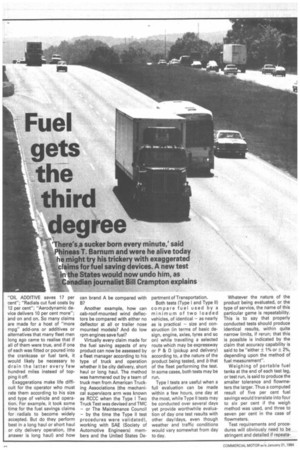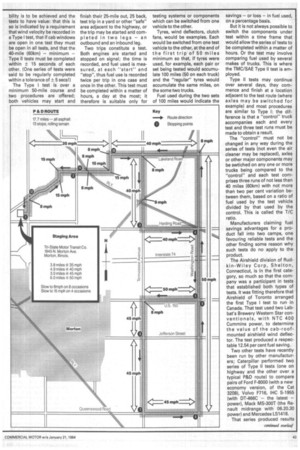Fuel gets the third degree
Page 46

Page 47

Page 48

If you've noticed an error in this article please click here to report it so we can fix it.
`There's,a sucker born every minute,' said hineas T. Barnum and were he alive today e might try his trickery with exaggerated laims for fuel saving devices. A new test the States would now undo him, as anadian journalist Bill Crampton explains
"OIL ADDITIVE saves 17 per cent"; "Radials cut fuel costs by 12 per cent"; "Aerodynamic device delivers 10 per cent more"; and on and on. So many claims are made for a host of "more mpg" add-ons or additives or alternatives that many fleet men long ago came to realise that if all of them were true, and if one of each was fitted or poured into the crankcase or fuel tank, it would likely be necessary to drain the latter every few hundred miles instead of topping it off.
Exaggerations make life difficult for the operator who must rate them according to his size and type of vehicle and operation. For example, it took some time for the fuel savings claims for radials to become widely accepted. But do they perform best in a long haul or short haul or city delivery operation, (the answer is long haul) and how can brand A be compared with B?
Another example, how can cab-roof-mounted wind deflectors be compared with either no deflector at all or trailer nose mounted models? And do low rpm engines save fuel?
Virtually every claim made for the fuel saving aspects of any product can now be assessed by a fleet manager according to his type of truck and operation whether it be city delivery, short haul or long haul. The method was hammered out by a team of truck men from American Trucking Associations (the mechanical supervisors arm was known as RCCC when the Type I Two Truck Test was devised and TMC — or The Maintenance Council — by the time the Type II test procedures were validated), working with SAE (Society of Automotive Engineers) members and the United States De partment of Transportation.
Both tests (Type I and Type II) compare fuel used by a minimum of two loaded vehicles, of identical — as nearly as is practical — size and construction (in terms of basic design, engine, axles, tyres and so on) while travelling a selected route which may be expressway or P & D (pickup and delivery) according to, a the nature of the product being tested, and b that of the fleet performing the test. In some cases, both tests may be run.
Type I tests are useful when a full evaluation can be made within a few hours, one day at the most, while Type II tests may be conducted over several days yet provide worthwhile evaluation of day one test results with other day/days, even though weather and traffic conditions would vary somewhat from day to day. Whatever the nature of the product being evaluated, or the type of service, the name of this particular game is repeatability. This is to say that properly conducted tests should produce identical results, within quite narrow limits, if rerun; that this is possible is indicated by the claim that accuracy capability is said to be "either ± 1% or ± 2%, depending upon the method of fuel measurement".
Weighing of portable fuel tanks at the end of each test leg, or test run, is said to produce the smaller tolerance and flowmeters the larger. Thus a computed result of five per cent fuel savings would translate into four to six per cent if the weigh method was used, and three to seven per cent in the case of flowmeters.
Test requirements and procedures will obviously need to be stringent and detailed if repeata bility is to be achieved and the tests to have value: that this is so is indicated by a requirement that wind velocity be recorded in a Type I test, that if cab windows are open in one test they must be open in all tests, and that the 40-mile (60km) — minimum — Type II tests must be completed within ± 15 seconds of each other. (One series of tests were said to be regularly completed within a tolerance of ±. 5 secs!) The Type I test is over a minimum 50-mile course and two procedures are offered; both vehicles may start and finish their 25-mile out, 25 back, test trip in a yard or other "safe" area adjacent to the highway, or the trip may be started and completed in two legs — an outbound and an inbound leg.
Two trips constitute a test. Both engines are started and stopped on signal; the time is recorded, and fuel used is measured, at each "start" and "stop", thus fuel use is recorded twice per trip in one case and once in the other. This test must be completed within a matter of hours, a day at the most; it therefore is suitable only for testing systems or components which can be switched from one vehicle to the other.
Tyres, wind deflectors, clutch fans, would be examples. Each would be switched from one test vehicle to the other, at the end of the first trip of 50 miles minimum so that, if tyres were used, for example, each pair or set being tested would accumulate 100 miles (50 on each truck) and the "regular" tyres would accumulate the same miles, on the some two trucks.
Fuel used during the two sets of 100 miles would indicate the savings — or loss — in fuel used, on a percentage basis.
But it is not always possible to switch the components under test within a time frame that would allow the series o tests to be completed within a matter of hours. Or the test may involve comparing fuel used by several makes of trucks. This is where the TMC/SAE Type II test is employed.
Type II tests may continue over several days, they commence and finish at a location adjacent to the test route (where axles may be switched for example) and most procedures are similar to Type I: the difference is that a "control" truck accompanies each and every test and three test runs must be made to obtain a result.
The "control" must not be changed in any way during the series of tests (not even the air cleaner may be replaced), axles or other major components may be swtiched on any one or more trucks being compared to the "control" and each test comprises three runs of not less than 40 miles (60km) with not more than two per cent variation between them, based on a ratio of fuel used by the test vehicle divided by that used by the control. This is called the TIC ratio.
Manufacturers claiming fuel savings advantages for a product fall into two camps, one favouring reliable tests and the other finding some reason why such tests do no apply to the product.
The Airshield division of Rudkin-Wiley Corp, Shelton, Connecticut, is in the first category, so much so that the company was a participant in tests that established both types of tests. It was fitting therefore that Airshield of Toronto arranged the first Type I test to run in Canada. That test used two Labbat's Brewery Western Star conventionals, with NTC 400 Cummins power, to determine the value of the cab-roofmounted airshield wind deflector. The test produced a respectable 12.54 per cent fuel saving.
Two other tests have recently been run by other manufacturers; Caterpillar performed two series of Type ll tests (one on highway and the other over a typical P&D route) to compare pairs of Ford F-8000 (with a new economy version, of the Cat 3208), Volvo F716, IHC S-1955 (with DT-466C — the latest — power), Mack MS-300T (the Renault midrange with 06.20.30 power) and Mercedes LS1418.
That series produced results of 11 to 19 per cent (on highway) and 12 to 17 per cent (P&D) in favour of Cat. The test vehicle was a Ford 700 converted to diesel, with a 3208T modified to a 3208E.
To a considerable extent the tests confirmed that which had already been established by all makers of 250hp up engines; fewer revolutions per minute per mile equals economy. A 3208T can be upgraded to 3208E by changing turbo's and governor springs.
Michelin Tyre ran a series of Type I tests in Chicago, Atlanta, New Jersey, Kansas City and Sacramento, comparing its lowprofile radials with Goodyears. The first two tests compared only drive axle tyres; Pilate XDA (275/80R22.5) travelled 50 miles on one truck and were then changed for the G167 (285/75R24.5) on the other, after which the second test run of 50 miles was completed. All tyres were exchanged for the last three tests in the series. Again drive axles carried XDA and G167s.
-Michelin low-profiles matching the XDA were Pilote XA (275/80R22.5); Goodyear G167s were paired with G159 (295/75R22.5). All rigs were semi's, and in each test tractors were matched by make, engine and approximate mileage (the latter ranging from about 10,000 miles for the first pair to run, and up to almost 500,000 miles each on the last pair).
Two tests used paired 1HCs, the other paired Whites, Peterbilt and GMC Astros. Trailers were similarly matched and equally loaded to obtain matched loads of about 75,000lb gvw.
Fuel was measured with meters said to be accurate to ± 0.5 per cent; fuel and mileage were measured at the beginning, midway, and termination points, under the eye of one or the other members of a scientific testing house who also took independent reading for comparison.
Results favoured Michelin in all cases. Changing drive axle tyres only, produced 3.5 and .2.71 per cent while changing all 18 tyres produced 7.39, 7.01 and 7.54 per cent. Similar tests would later be run in Canada.
The Caterpillar/Ford Type II tests and the Michelin Type I, would never have been run, certainly not before witnesses, had the manufacturers not been confident of the results.
So, Mr Fleet Operator, if you would like to check out that attractive fuel saving claim before investing a few thousand dollars (perhaps never to be quite sure you acted wisely), all you need are a matched pair of your own vehicles, in good mechanical shape (no body tears, and alignment checked), your very best drivers who know the route (which will be typical of your normal hours), and one of whatever gismo it is you are hoping will work.
You will complete a pair of Type I tests in a morning.
















































































